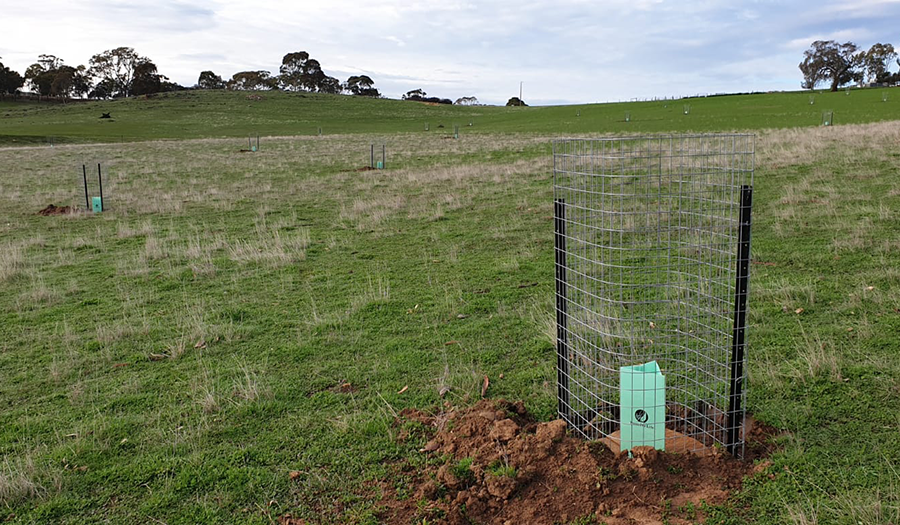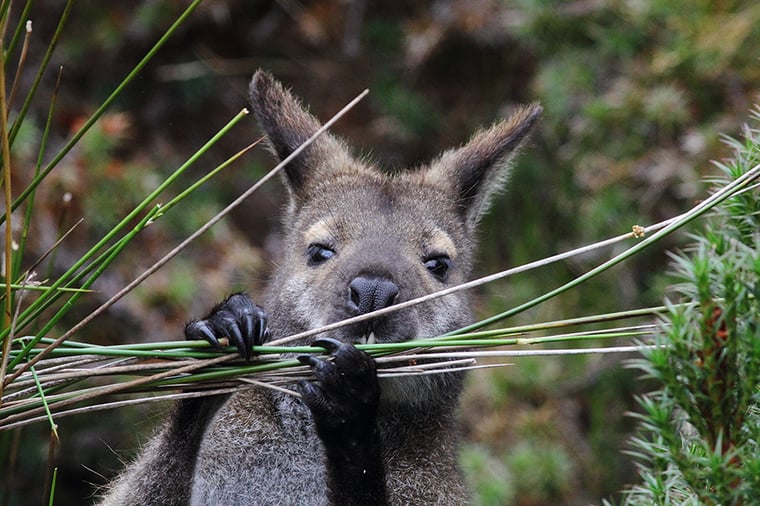Revegetation Tree Protection: Guarding your Garden

The planting stage of your revegetation project may be complete, but it isn’t just you who will enjoy your new seedlings. A wide variety of native and domestic animals will enjoy them too. And they will enjoy eating them!
Newly planted seedlings or direct seeding projects are highly susceptible to being grazed on, trampled on, or even damaged by the climatic conditions themselves. An experienced nursery person will likely put the seedlings through a ‘hardening’ process in the nursery to minimise the shock of being planted out on a revegetation site. But they will still likely need some form of protection from animal predation and potentially from climatic conditions.
Two commonly used ways to protect seedlings are tree guards around individual seedlings or fencing off the revegetation site. Both processes have merits, and sometimes both are needed in one project, depending on the likely predation present.
Consider potential seedling predators early in your planning stage, and design a protection system into your revegetation plan. Your protection system may include a pre-planting predator control program, such as baiting for rabbits. On rare occasions, it may be necessary to consider the control of protected native animals, but exclusion is always the best first option! First, obtain a permit where protected animal species are involved, as native animals are protected under conservation acts. You may also need a permit to control vermin animals, depending on the animal and the type of control you’re using.

Image: Red-necked wallaby at St. Clair National Park in Tasmania.
Predators vs protection methods
Consider the various types of predation or damage that may occur to your seedlings. There will likely be a combination of different predators.
Small predators may include rabbits, hares, or similar sized animals. Protection from these animals will only require tree guards of sufficient height and strength to stop them from grazing until the seedling is strong enough to withstand the grazing. Tree guards suitable for smaller predators include rigid ‘fluted’ plastic guards, cardboard carton guards, small mesh guards or sleeve type guards held in place with various hardwood stakes or bamboo canes.
Larger predators may include wallabies, kangaroos or domestic animals such as sheep, cattle and similar livestock. Feral animals such as deer may also pose a threat. These predators require larger, more robust tree guards, such as moderate to large steel mesh guards, as these large predators have the strength and size to push over the guards or reach into the smaller tree guards. These stronger tree guards are typically supported with solid hardwood stakes or even steel star pickets.
Birds or insects may also pose a risk to the revegetation project. Birds interested in seeds usually target direct seeding sites, and insects can devastate young seedlings when in high numbers. Suppose evidence of insect damage is near the revegetation site. In that case, you could achieve protection by using a systemic insecticide put into the soil at the time of planting or installed after planting when it becomes apparent that insects are affecting the plants. Protecting direct seeding from birds can be problematic, but hydroseeding or spreading different mulch types can help limit this.
Site conditions determine guard type
An inland temperate zone might benefit from a rigid ‘fluted’ plastic guard providing long-lasting protection against smaller animals, wind protection and a mini “micro-climate” for the plant.
Riparian sites, where there is a risk of tree guards ending up in waterways, would benefit from a biodegradable tree guard that will break down without damaging the environment. A biodegradable guard is also an excellent option when there isn’t a budget to remove the tree guard after the successful establishment of the revegetation.
Coastal sites, where winds are high and steel rusts quickly, may be best suited to a plastic mesh guard that won’t rust and will allow the wind to move through the guard without scouring the soil and exposing the seedlings’ roots. It’s worth bearing in mind that open mesh tree guards don’t allow follow up weed control spraying to be efficiently completed, as the “spray drift” through the mesh can result in off-target damage to the seedlings.
The table below shows some of the key advantages and disadvantages of smaller guard types.
| Guard Description (click each product to learn more) |
Cost Effective | Easy Install | Spray Drift Protection | Reusable | Degradable |
Weather Protection | Creates Micro-Climate |
Disadvantages or other comments |
| 1L milk carton tree guard Requires 2x bamboo stakes per guard. Product Code: PLMC1-290 |
☑️ | ☑️ | ☑️ | ☑️ | ☑️ | ☑️ |
|
|
| 2L milk carton tree guard Requires 2x bamboo stakes per guard. Product Code: PLMC2-250 |
☑️ | ☑️ | ☑️ | ☑️ | ☑️ | ☑️ |
|
|
| 10L cardboard carton tree guard Requires 2x bamboo stakes per guard. Product Code: PLMBTG1545 |
☑️ | ☑️ | ☑️ | ☑️ | ☑️ | ☑️ |
|
|
| 435mm cardboard BioGuard Requires 1x flat hardwood stake, 2x in high wind areas. Product Code: PLMBIOG435 |
☑️ | ☑️ | ☑️ | ☑️ | ☑️ |
|
||
| 450mm Polymesh tree guard Requires 2-3 bamboo or hardwood stakes per guard. Product Code: PTG4540 |
☑️ |
|
||||||
| 900mm Polymesh tree guard Requires 1x flat hardwood stake, 2x in high wind areas. Product Code: PTG9040 |
☑️ |
|
||||||
| 450mm Corflute welded guard Requires 1x hardwood stake per guard, plus 1x bamboo stake in high wind areas. Product Code: TSCOR4520 |
☑️ | ☑️ | ☑️ | ☑️ | ☑️ |
|
||
| 600mm Corflute welded guard Requires 1x hardwood stake per guard, plus 1x bamboo stake in high wind areas. Product Code: TSCOR6020 |
☑️ | ☑️ | ☑️ | ☑️ | ☑️ |
|
||
| 450mm Mallee tree sleeve Requires 3x bamboo stakes per guard. Product Code: TS5435L-A |
☑️ | ☑️ | ☑️ | ☑️ |
|
The table below shows some of the key advantages and disadvantages of larger guard types.
| Guard Description (click each product to learn more) |
Cost Effective | Easy Install | Spray Drift Protection | Reusable | Degradable |
Weather Protection | Creates Micro-Climate |
Disadvantages or other comments |
| 800mm x 300mm Mallee Mesh Wallaby Guard Requires 2x hardwood stakes and fixing rings per guard. Product Code: PLSMT800350 |
☑️ | ☑️ | ☑️ |
|
||||
| 1200mm x 460mm Mallee Mesh Kangaroo Guard Requires 2x hardwood stakes and fixing rings per guard. Product Code: PLSMT1500430 |
☑️ | ☑️ | ☑️ |
|
||||
| 1500mm x 760mm Mallee Mesh Sheep Guard Requires 2x hardwood stakes and fixing rings per guard. Product Code: PLSG1500-SET |
☑️ | ☑️ |
|
|||||
| 1950mm x 750mm Mallee Mesh Cattle Guard Comes as a kit which includes star pickets and barbed-wire for protection. Product Code: PLCG19501500 |
☑️ | ☑️ |
|
Additionally, consider the size of your site and for what you will be using it. It may be more cost-effective to protect a large site with high-density plantings by putting a vermin-proof fence around the project rather than individual guards. Fencing is also beneficial for windbreak type plantings along the edge of a paddock. Conversely, a large site with very scattered plantings and grazed with cattle would naturally suit larger, stronger individual guards.
Next steps
When deciding on the best way to ensure your seedlings have proper protection from predation and climatic conditions, many factors come into play! If you have any questions regarding which guard is best suited for your project, get in touch with our team of advisors. Please email us at info@arborgreen.com.au.
In our next post, we’ll consider some of the recycling options for tree guards, review some biodegradable options and whether a tree guard’s material is compostable or not.
If you've recently completed a noteworthy tree planting or bush revegetation project and you would like to feature your planting project, follow this link to fill in your project details.
Access the full Revegetation blog series.
/Arborgreen%20-%20DGreen%20-%20RGB%20-%20Sml.png?width=1045&height=347&name=Arborgreen%20-%20DGreen%20-%20RGB%20-%20Sml.png)

